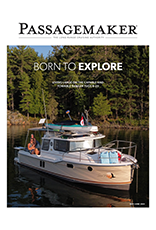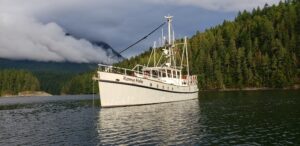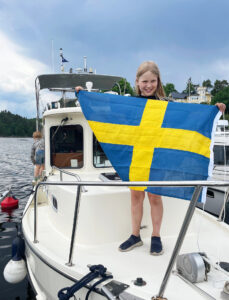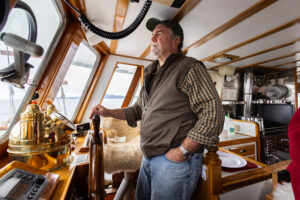My bucket list consumes me. As I grow older, it tells me where to go, what to do, and with whom to do it. That’s why, newly retired, I chartered a 30-foot steel trawler in north Holland and convinced my wife, Grace, that it would be the best summer vacation yet.
Truth be told, this was my third attempt at chartering a boat in the country’s renowned Friesland province. Years prior, my first two attempts were thwarted by work obligations and the pandemic. But this time, on a warm summer day, Grace and I boarded our chartered boat, Tigris, and set off on a do-it-yourself Dutch adventure.
Friesland is known throughout Europe as a premier boating destination. Located northeast of Amsterdam and south of the Wadden Sea, its numerous rivers and canals connect several lakes and virtually all of the major towns in the province. It’s a rich cruising ground where the countryside has boating infrastructure and restaurants that serve cold beer and exotic cheese. It’s a paradise for the slow cruiser.

We planned to cruise for 14 days, crawling from one fascinating destination to the next. This would be a chance to reacquaint ourselves with the cruising lifestyle, something we had dabbled in by sailboat a decade before. It would also be a chance to test drive some bits and bobs I might put back into my own self-built boat, a bare-hull pocket trawler languishing in my garage back in Detroit. But most important, this was my chance to convince my wife that we should someday see the world from the water in a trawler. She was, but is no longer, skeptical.

Our boat was a Simmerskip 900 from Yachtcharter Wetterville in Terherne. Simmerskip means “summer ship” in the Frisian language, and Wetterville means “water fun.” In the Netherlands, almost everyone speaks English, and of course Dutch, with Frisian reserved for the true locals and great monikers.
While there are dozens of charter companies offering boats for self-drive vacations, it was Yachtcharter Wetterville’s comprehensive website and information in Dutch, English and German that helped me choose that company. Renting a steel trawler requires payment ($1,000 to $3,000 per week, depending on boat size) and not much else. You don’t need a license to captain a charter boat as long as it goes less than 6 knots, which is also the maximum speed limit on Dutch waterways in most places. Wetterville boasted that even a beginner can charter a boat after a six-hour course in skippering.

The boat came fully outfitted, including with paper charts. At just a hair under 30 feet, it had a pilothouse helm/salon, V-berth cabin, head/shower combo and galley. It was powered by a late-model, 40-hp Nanni diesel, and equipped with bow and stern thrusters. It closely resembled the fiberglass trawler I was building, but with shallow air draft and even shallower draft.

After a 30-minute walkthrough with the charter operators, we overnighted on board in the basin to recover from jet lag. We started the next morning after a lazy in-town breakfast. Our first stop would be the town of Sneek, just an hour away. Our schedule seemed so unambitious, but in Friesland, the water towns are all within minutes to hours of slow cruising. I wanted to take some time to understand the local charts, develop a strategy, plan a route and, frankly, convince myself that I could really skipper a steel trawler for two weeks on my own.

Over cold drinks, local cheese and bitterballen (a Dutch meat snack), a plan began to materialize. We decided to cruise along parts of the 11 Cities Route, what the Dutch refer to as Elfstedentocht (in the winter, this 100-kilometer route becomes the backdrop of a famous winter ice skating race). Just like the ice skaters, we would follow the canals, town to town, stopping to explore.

No matter the type—ancient fortified town or port city—each destination offered berths for traveling boaters. You can overnight at a marina for a few dollars a foot, or use the municipal moorings scattered in the town centers. We booked municipal moorings by app, reveled in the free electrical and water hookups, used the clean bathrooms, and streamed on the free Wi-Fi. We rarely paid more than $16 a day for a berth. Farther afield, there are marrekrites, or free moorings where you can overnight or tie up during a long lunch or afternoon nap. These are often remote amid nature, but always accessible by bicycle paths.

We quickly settled into a routine. We’d wake around 7:30 a.m, have a leisurely breakfast while studying the local charts, and plot our route with pencil and paper. This was real salty boating: no VHF radio and no GPS. In Friesland, the bridges don’t open before 9 a.m., so there was no rush to get started. We’d motor at 5 or 6 knots to the next town, usually making landfall around noon. Arriving early guaranteed us the choicest moorings. Every day was an afternoon of sightseeing followed by a night of dinner and drinks ashore.

Out of the corner of my eye, I saw Grace beginning to love every minute of it. Gone was the trepidation of steering the boat, navigating around sailboats, scows and commercial tugs, even mooring in tight quarters.


Everywhere we went, people greeted us with enthusiasm and questions about where we’d just been and where we were going next. It was if the entire region existed solely for the slow boater’s pleasure.
By the fourth day, Grace became captain. I was demoted to galley and bridge duty—and there were an infinite number and variety of bridges. On one leg of the journey, I counted more than 30. In many places, Tigris could scoot under with nary centimeters to spare, and in others, I had to press a button to self-actuate the bridge, or signal the bridgetender. Sometimes we paid a small toll, but most times, just a wave and a smile.

There were architectural marvels everywhere, like the 13th-century glass church in Bolsward, or the Oldehove, a 9th-
century leaning church tower in Leeuwarden. And of course there were windmills. Big ones, small ones, old ones, new ones. In the town of Franeker, we discovered the Royal Eise Eisinga Planetarium, the oldest-working orrery in the world, recently named a UNESCO World Heritage Site.

Each town was better than the last. The scenery played out like an orchestra: equal parts quaint villages, amazing wildlife and natural beauty. Sometimes we just had to stop and enjoy being the only ones on the waterway for as far as the eye could see.
Fresh seafood was abundant, but so were coffee shops and gastropubs. We found a steakhouse off the beaten path. Because of the boating infrastructure, the bathroom and pumpout facilities were unlike anything I ever experienced in the United States. They were, in a word, proper.

The high point of the trip came on the 11th day as we trekked far to the north, almost to the Wadden Sea. In the tiny town of Dokkum, we paid the bridgetender the toll by using a fishing pole and an old wooden shoe. As I navigated into the center of town, my wife called out one good mooring after another. And I got to tick off a very specific item on my bucket list.
I wanted to spend the night on a proper little boat under a giant windmill. That’s just what we did.
This article was originally published in the July/August 2024 issue.











